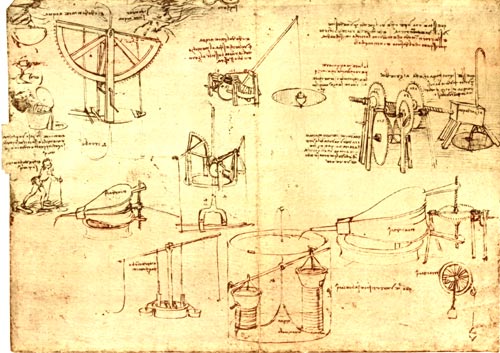Engineering history and practices
Engineering work takes its roots in the earliest antiquity. Ancient civilizations, Egyptians, Greeks, Romans or Chineses have left numerous traces that demonstrate their mastery in the art of engineering : Pyramids, aqueduct (Samos, 600 BC), war machineries (Catapults in 400 BC in Greece) or fortifications (Great wall of China, 220 BC). The great figures of this period are Imhotep, Archimede, Thales and Vitruvius.
At the Renaissance (15th century), engineers have a universal knowledge and a broad range of skills: artist, scientist, inventor, architect, philosopher, anatomist, etc. Leonardo Da Vinci is the key personality that enlightened the Renaissance with its outstanding talent. Other major figures, such as Francesco Di Giorgio, have left a rich legacy, especially in architecture and machinery design.
The modern times have brought some important developments in the engineering profession. In France, engineers have been organized in senior branches by the centralized administration: mining, civil, military, electrical, etc. The French engineering schools ("Grand Schools") are founded in the 18th century, such as the Polytechnic School in 1794. Engineers play then a great role in the industrial expansion of Europe.
With the acceleration of advances in sciences and technologies, contemporary engineers tend to become more and more specialized. Some outstanding personalities mark in their turn the history of engineering, such as Thomas Edison (electrical engineering), Gustav Eiffel (civil engineering), Marcel Dassault (aircraft engineering) or Alan Turing, John Von Neumann and Seymour Cray in computer science engineering.
The present time reveals the fantastic course of technical advances through time. The richness of the inventions and the continuous improvement of our knowledge and practices contribute to model the civilization and shape the future world in which we will live.
Innovation and esthetic design
Innovation and creation are so tightly linked, that engineering and artistic work have been fulfilled by the same individuals in some periods of the history. Inventing and creating new solutions contributes to improve and ease the human life, generates productivity gains and feed the engine of growth and progress. However, in today's competition, innovation has become sometime an overused concept that should be considered with a critical eye.
The esthetic design of an objects is related to the idea of pleasure of using it and owning it. In some cases, the esthetic design of a solution can demonstrate, through an intuitive feeling, the intrinsic qualities of the final product. Marcel Dassault used to say that a beautiful plane always fly very well. This intuitive approach of engineering can complement the use of classical engineering techniques and rational studies. Joining both approaches can allow to create high performance, reliable and successful solutions.
Personal course
On a personal perspective, the choice of an engineering career has for origin a curiosity for scientific and technical subjects, the taste of learning continuously and the pleasure of creating and designing new products or services, either useful or playful.
Moreover, the process of acquiring an in-depth expertise in an high-tech engineering domain (such as computer science) and designing innovative solutions brings some great satisfactions. This fulfilment is linked to the creative dimension of the work and the feeling of using the maximum of our abilities and knowledge in an advanced domain to produce a specific added value.
After a carreer course as a software engineer, IT architect, project manager and finally enterprise architect, my current orientation consists in consolidating this engineering culture and know-how, in order to get a new light and vision on the evolution of the information technology environment. This experience and approach is materialized today through an activity of freelance consultant in IS/IT architecture.
Beyond this current activity, a fundamental personal objective lies in extending the spectrum of my studies towards various subjects related to computing and IT: cognitive sciences, natural human mechanisms of expression, knowledge-based interactions and new paradigms of human-computer interfaces, in the perspective of the Web2.0 developments. These studies are at the origin of an original project, with the aim to introduce a more "human", spontaneous and pleasant approach in the use of new internet services.
This Web2.0 venture project is currently in an early stage phase, looking for seed financing. An executive summary and a business plan are available on demand for investors.
Contact: smonteil@laposte.net

Leonardo Da Vinci (1452-1519) - Codex Atlanticus
Further resources
- Engineering (Wikipedia)
- Archimedes The Palimpsest
- Roman Engineering (Wikipedia)
- Four Great Inventions of ancient China (Wikipedia)
- Francesco Di Giorgio biography (Web Gallery of Art)
- Universal Leonardo (University of the Arts, London)
- Leonardo Da Vinci - Codex Atlanticus (Biblioteca Ambrosiana)
- Renaissance man - Polymath (Wikipedia)